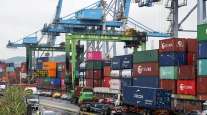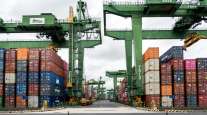Global Trade Growth Is About to Roll Over

Signs are pointing to a looming slowdown in global trade growth, according to Morgan Stanley.
Each component of the bank’s proprietary global trade leading indicator — save for the U.S. dollar — declined in April to mark back-to-back drops for the index, which is used to forecast real activity with a one-month lead.
"Business sentiment, crude oil, commodity prices and Baltic Dry Index shipping rates all pulled the index lower," said a team led by economist Elga Bartsch. "If [the] Morgan Stanley global trade leading indicator declines three times in a row, we will likely have established a new downtrend in global merchandise trade dynamics."
Morgan Stanley anticipates a short divergence between its leading indicator and global trade volumes (measured by the CPB World Trade Monitor), estimating that the latter will still rise at about a 10% pace year-over-year for May. Going forward, however, negative base effects are likely to amplify the headwinds of "less favorable trends in commodity prices, the U.S. dollar and shipping rates."
In an ironic twist, Donald Trump’s election victory — following a campaign with clear protectionist overtones amid a retreat in shipping activity worldwide — coincided with a sharp acceleration in global trade that carried through to the first quarter of 2017 and beyond.
"As the strong trade data from Q1 rolls in think now clear 'deglobalization’ of last 2 ys a function of China’s slowdown and commodity shock," Council on Foreign Relations senior fellow Brad Setser said on Twitter.
As the strong trade data from q1 rolls in think now clear "deglobalization" of last 2 ys a function of china's slowdown and commodity shock — Brad Setser (@Brad_Setser) April 27, 2017
Now, not only trade, but another key tenet of the global reflation thesis is poised to fade.
"Global growth has moved from boiling to merely simmering," wrote Credit Suisse Group AG analysts led by James Sweeney in a May 2 note. "We estimate that global industrial production momentum (3m/3m annualized growth rate) has fallen from a 5% January peak to under 4% in April."
Credit Suisse expects industrial production momentum to continue to wane, with the growth rate falling to 3% this summer.




